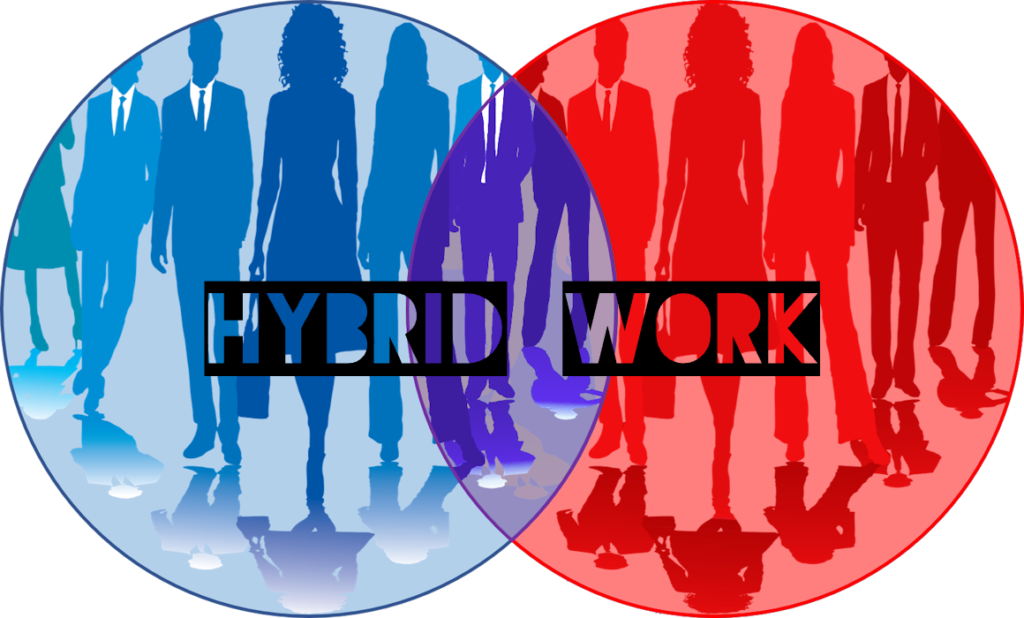When the pandemic struck in early 2020, few people viewed it as the beginning of a global social experiment. Nevertheless, as journalist Emma Goldberg (@emmabgo) explains, it has proven to be multi-year, 50-million-person experiment in changing how we work.[1] She adds, “The office was never one size fits all. It was one size fits some, with the expectation that everybody else would squeeze in.” The pandemic work environment has often been described as hybrid work. Tiffany Fowell, a content creator at Envoy, insists, “Hybrid work is a drastic departure from the traditional work model.”[2] Fowell goes on to note that there is no single hybrid work model. “Hybrid work has many variations,” she writes. “Some companies might allow every employee the flexibility to work on-site and remotely part of the week. Other companies might have employees working either full-time remote or full-time on-site. And others might allow a combo of the two.”

Business journalist Libby Cherry (@LibbyCherry98) insists “the hybrid work revolution is already transforming economies.”[3] She believes, “Office workers are being set free. Experts say that offers a rare opportunity to kickstart sluggish economies.” The question remains: Will hybrid work continue once the pandemic ends? According to Mark Ridley (@Mark_Ridley), founder and of CTO of Ridley Industries and former CTO of the Financial Times, the answer to that question is yes.[4] He believes, “Whether we work in a hybrid way or fully remotely, we’ll see a change in the way we train and learn, and the ways in which we engage with our employers and customers. There’s a rush in some sectors to get back to the office, but we’ve broken that habit now and there won’t be a full return.”
The Future of Hybrid Work
One of the reasons hybrid work is likely to hold a permanent place in the business landscape is because workers appreciate the flexibility it provides. Fowell reports, “A survey conducted [by Envoy and] Wakefield Research shows that almost half of employees (47%) would likely look for a [new] job if their employer doesn’t adopt a flexible working model.” With so many companies looking for employees, hybrid work options are a valuable incentive if a company’s business model can support it. According to Goldberg, the number of workers experiencing hybrid work grew dramatically during the pandemic. She explains:
“The last two years ushered in an unplanned experiment with a different way of working: Some 50 million Americans left their offices. Before the pandemic, in 2019, about 4 percent of employed people in the U.S. worked exclusively from home; by May 2020, that figure rose to 43 percent, according to Gallup. Of course, that means a majority of the work force continued working in person throughout the last two years. But among white-collar workers, the shift is stark: Before Covid just 6 percent worked exclusively from home, which by May 2020 rose to 65 percent.”
Technology writer Will Knight (@willknight) predicts that even more of the workforce will join the ranks of those enjoying hybrid work. He cautions, however, that such a shift could be good for some workers but bad for those who are displaced by robots. He explains, “Many office workers have gone remote during the pandemic, with some firms making the shift indefinite. But the continued challenges posed by the virus and a deepening labor shortage — combined with advances in technologies such as AI and virtual reality — are allowing a small but growing number of physical jobs to go remote as well. … The approach can help companies find new workers and create more efficient processes, but it could be less positive for workers. Some remote jobs are handled by lower-paid workers overseas. And some companies see remote human labor as a temporary way to train AI algorithms that will eventually replace them.”[5]
Adapting to this new work environment may be a matter of survival for some companies. Analysts from the Boston Consulting Group (BCG) explain, “The best leadership teams have spent the past two years leaning into the changes COVID-19 has brought to their organizations. As a result, their companies will have a definitive customer, innovation, employee, and productivity advantage for years to come. Other companies — those that are not rapidly locking in and extending how they serve customers and communities and support their people — will lose.”[6] They add, “Embracing, rather than trying to recover from, the organizational disruption caused by the pandemic will provide a rich source of new and improved work practices.”
Concluding Thoughts
Although there might be some unexpected consequences as a result of the significant rise in hybrid work, some of those consequences are already being felt. Cherry observes, “While a more permanent transformation of working life will have painful consequences for many inner-city businesses, economists see a recalibration underway that can revitalize smaller towns and suburbs. New digital tools mean that retail and hospitality — as well as knowledge-intensive industries — are already undergoing far-reaching change.” As Cherry implies, urban office spaces, which were at a premium prior to the pandemic, are likely to be less valuable if they don’t once again fill to capacity. And municipal transportation systems dependent on commuters could also suffer.
On the other hand, there is some good news. Business executives, who once worried that allowing people to work from home would diminish productivity, have been pleasantly surprised. Cherry reports, “Working from home around one day a week will boost productivity by 4.8% as the post-Covid economy takes shape, according to a recent study of more than 30,000 U.S. employees co-authored by José María Barrero of Instituto Tecnológico Autónomo de México and others. Much of that one-off increase is projected to come from reduced commuting time, a factor not usually captured by economists. The transformation will deliver enduring benefits, according to Steven J. Davis of the University of Chicago, who studies the evolving workplace and was one of the authors of the productivity study. The ‘positive consequences will be there indefinitely,’ Davis said.”
One thing is becoming clearer: Employees love the flexibility offered by hybrid work. Not only are they freed from the hassles of commuting, Fowell believes hybrid work brings greater balance into peoples’ lives. She explains, “A recent study by Slack found that flexibility is a key reason employees are attracted to the hybrid work model. Finding balance is easier in a flexible work arrangement. When employees have more control of their work schedules, they can free up time to take care of the things that crop up in their personal lives — whether it’s running an errand, picking up kids from daycare, or being home for a delivery.”
BCG analysts conclude, “No one (hopefully) believes in returning to the past, when work happened primarily with colleagues who adhered to fixed hours and locations whether it was necessary or not. Nor is the opposite extreme, where work is entirely remote and/or occurs at unpredictable times, a viable long-term strategy. People still want — and sometimes need — to meet physically, with predictable hours, to collaborate, cocreate, and congregate.” To meet the needs of the hybrid work environment, BCG analysts recommend taking four steps to create differentiated work models. Those steps are:
Step 1. Align on the business outcomes and guardrails for future work models. “The CEO and executive team need to agree on what they are solving for (what mix of employee satisfaction, productivity, or cost reduction, for example) and the associated guardrails (such as maintaining flexibility, creating meaningful time together, and ensuring a level playing field for all talent).”
Step 2. Determine the range of work models based on the work and the people. As noted above, there are a variety of work models that can be adopted. BCG analysts suggest business leaders should ask, “What ‘deskless’ jobs — in manufacturing, hospitality, retail, or health care, for example — need to be done in person but can offer flexible shift timing and/or allow for shift exchanges when personal needs arise? What ‘desk-based’ jobs can be done by bringing a laptop home but still need time for teams to come together to ensure collaboration and creativity — and with what frequency should those teams meet in person? Which of our people are more comfortable, engaged, and productive in flexible models?”
Step 3. Provide teams with the knowledge, skills, and tools to develop their working norms. Since hybrid work is relatively new, learning what works best is going to take some time. BCG analysts explain, “Teams will need to establish their own cadence for working in person and apart, and they will need to agree to specific norms around communication, work planning, collaboration, and learning. For example, adopting a ‘one person on screen, everyone on screen’ rule — in other words, asking those who are attending a meeting in person to join virtually on their laptops so that those working remotely can see their individual faces and not feel disadvantaged — will maintain the level playing field created by the pandemic. Teams will also need tools that enable hybrid scheduling and optimize space utilization. And teams need weekly time to reflect on and evolve their working norms.”
Step 4. Build the learning ecosystem. When Mitt Romney was running for president back in 2011, he was chided for saying, “Corporations are people.” He tried to explain that corporations are run by people, they employ people, and their customers are people. In other words, he was trying to make the point that corporations are part of a larger ecosystem. And that ecosystem needs to be tended if it is to blossom. BCG analysts note, “It is important to recognize that these new ways of working represent significant change — and that we all need to put in the effort to develop the right capabilities and skills to thrive in these new work models. Best practices, once established, need to be disseminated quickly and teams need to be upskilled rapidly. Companies should integrate AI-enabled skill and acumen assessment, always-on and applied learning, and individualized learning journeys to thrive in this new environment.”
According to Cherry, “Employers the world over are now grappling with [the shift to hybrid work] as they try to balance productivity growth with keeping staff creative and happy.” It’s a grand social experiment that wouldn’t have occurred had the pandemic not required it.
Footnotes
[1] Emma Goldberg, “A Two-Year, 50-Million-Person Experiment in Changing How We Work,” The New York Times, 10 March 2022.
[2] Tiffany Fowell, “Hybrid work: what is hybrid work and why do employees want it?” Envoy Blog, 2 February 2022.
[3] Libby Cherry, “The Hybrid Work Revolution Is Already Transforming Economies,” Bloomberg, 26 August 2021.
[4] Stuart Sumner, “Hybrid working: The office in 2022 and beyond,” Computing, 15 October 2021.
[5] Will Knight, “Now Physical Jobs Are Going Remote Too,” Wired, 27 January 2022.
[6] Deborah Lovich, Frank Breitling, Jonathan Feldman, Bharat Khandelwal, Chris Mattey, Prateek Roongta, Nick South, and Kristi Woolsey, “Work Will Never Be the Same—Savvy Business Leaders Are Adapting to Change That’s Already Here,” Boston Consulting Group, 17 February 2022.





